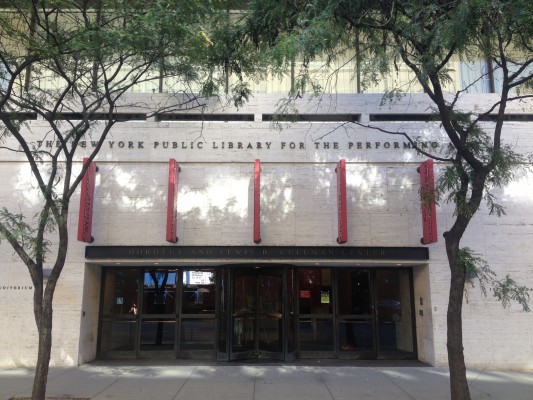Exploring the Library for the Performing Arts
October 2, 2013

One of the best underutilized resources for Fordham College at Lincoln Center is the branch of the New York Public Library (NYPL) dedicated entirely to the performing arts, located at Lincoln Center. The New York Public Library for the Performing Arts is home to just about every resource imaginable related to theatre, music and dance. Nestled between the Metropolitan Opera House and Lincoln Center Theater, the Library for the Performing Arts looks deceptively small from the outside, but holds countless treasures. Past the entrance and the circulation desk are the galleries, where the library’s curator and individual divisions present exhibits ranging from costume designs to drawings by Al Hirschfeld to the most recent display which featured album artwork, manuscripts, performance photos, tour memorabilia and more from San Francisco’s “Kronos Quartet.” Also down this hallway are a reading room and the circulating books of the Music Division.
The third floor is home to the ‘Theatre, Music and Dance Divisions’ research collections.
There are not many books specifically about dance, so the copies that the library does have must be used onsite so that no patron is ever stuck without a book that they need. “Dance is a pretty new field in terms of how we study it,” Arlene Yu said, a specialist in the Jerome Robbins Dance Division and the Archive of the Recorded Moving Image. “Theatre has scripts and music has scores. We don’t have a universal mark-up system.” The library is currently displaying some examples of early dance notation to underscore not only how foreign they are to modern eyes, but also how drastically different they are from one another.
“Now that we have cheap video, which we didn’t have until 10 or 15 years ago, there’s a lot more [preservation] going on,” Yu said. As in the past, library patrons can find a performance in the library’s catalog and have the video screened on the Dance Division’s monitors. Using the video players onsite, patrons can watch videos and also play different clips side-by-side. Due to copyright restrictions, only select videos are available to stream over any Internet connection but all can be watched onsite at the library.
Written scores, press clippings and personal papers are a common theme throughout each division. Whether a paper calls for telegrams received by Harold Prince during the original production of “Company,” choreographic notes from Agnes de Mille, or correspondence by Felix Mendelssohn, the collections at the Library for the Performing Arts most likely have it. Personal letters may not always be useful for student-researchers, but they can reveal surprising things about the writer. “[Correspondence is] sometimes just really awfully personal but sometimes it will give you an idea of where someone was or what they were thinking,” Yu said. “Sometimes you didn’t even realize that somebody else influenced [the writer] in a totally different field until you look at stuff like that.”
One unique feature of the Music Division is the song index, which contains sheet music for about 40,000 songs. A patron can search for a song they wish to view, bring the call number to the song index desk, and receive the sheet music. This music cannot leave the library, but can be looked at onsite or photocopied. Performers can save a ton of money by using the song index instead of buying entire songbooks for just one piece.
The Music Division also contains the Rodgers and Hammerstein Archives of Recorded Sound, which not only has recordings of music but of literature and speech, and the American Music Collection, which aims to preserve a copy of every piece of music published in the United States, according to the Curator of the collection, Jonathan Hiam. Nearly every imaginable musical interest is represented in the library, from J.S. Bach to Jerry Bock.
The final major division of the library is the Theatre Division. Since 1970, the Library for the Performing Arts has been making archival recordings of as many productions as possible. “It’s a wonderful resource. We’ve had anyone you can think of come in and look at things for their own work: Stephen Sondheim, Woody Allen, Mike Nichols, Donna Murphy,” Amy Schwegel, administrative assistant in the Billy Rose Theatre Division, said. Each researcher is limited to only one viewing of a specific tape, but the archive is still incredibly useful. Next time a theatre student has to cite a musical in a paper, why not view and cite the archival footage instead of referencing only what was preserved on the cast recording?
A quick glance through the Theatre Division’s holdings reveals original costume designs from “My Fair Lady,” the set model from “Follies,” production photos from nearly every show imaginable and Shakespeare scripts that are hundreds of years old. The most amazing part is not just that these historical items exist right next door, but that they can be accessed by anyone, including students of costume design, set design, directing, performance and stage management. It truly highlights the purpose of a public library and the privilege of having such an incredible one right next to campus.











